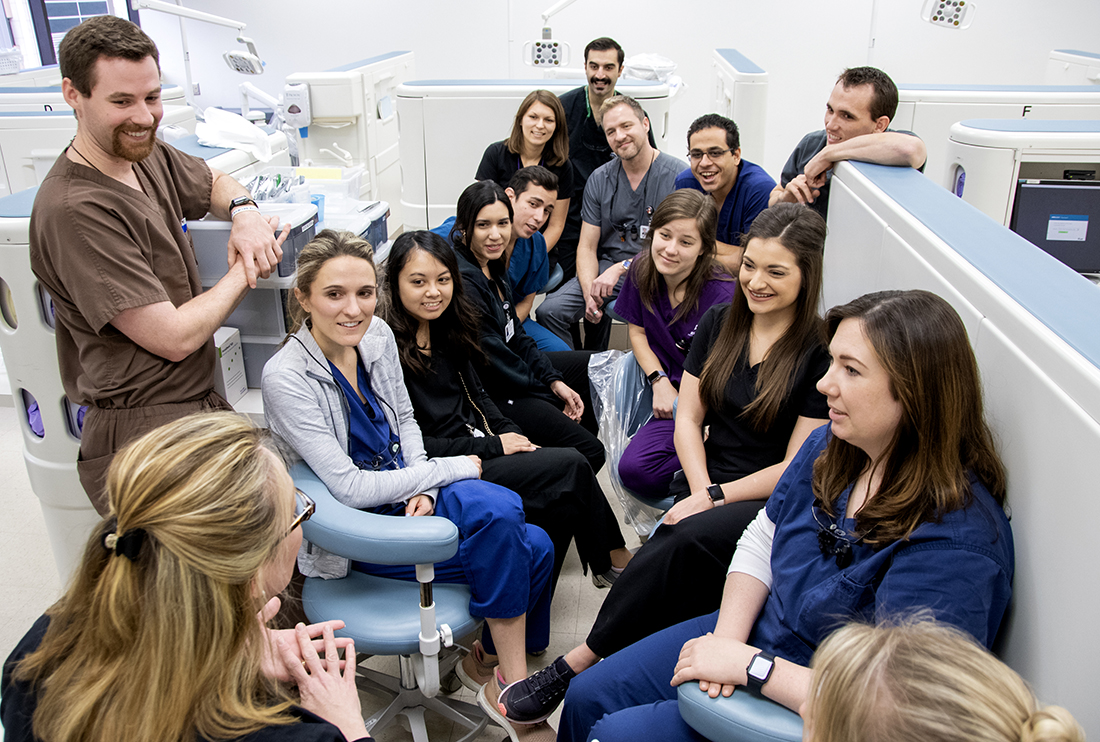The pilot program, a semester in

Revamping a dental school’s curriculum is far from an overnight process. It’s one that, in the case of Texas A&M College of Dentistry, has progressed into an intensive phase stretching over the course of an entire academic year and then some. The 12 students chosen to test-drive the college’s new patient-care model since June 2018 will likely tell you they’ve experienced lots of successes, a few approaches that have been improved upon, and one unexpected benefit: a level of collaboration with their instructors they never otherwise would have experienced.
“Our group leaders, Dr. Barrington and Dr. Allen, are always open to feedback and new ideas,” says D4 Cameron Keylor. “Whether it is a formalized survey or simply daily conversation in the clinic, they are constantly asking for our opinions. There is an open and honest dialogue between the instructors and the students on a daily basis, and I think that is why the program works so well.”
End-of-semester course assessments may offer students the opportunity to give feedback, but being asked point-blank by professors what they think is working — and especially what isn’t — offers an increased sense of ownership in their education.
“The pilot program leaders have been really great about asking us frequently how we feel like things are going, through surveys and team meetings,” says D3 Emily Watson. “I’m 100 percent confident that they genuinely care about the success of this program for the sole benefit of the students getting the most out of their years of clinic exposure.”
Dr. Jennifer Barrington, clinical associate professor in general dentistry, along with Dr. Sarah Allen, clinical associate professor in restorative sciences, oversees the pilot program, composed of six D3s, six D4s and eight faculty members. Anytime they encounter a problem — be it revamping current dispensary protocols to accommodate the new program’s patient appointment schedule or ensuring incoming D3s have beefed up radiology training prior to the fall semester so that they can take X-rays on their own — they arrive at a solution, in large part, because of student input. Cooperation with other departments, faculty and staff also is vital to this process.
“Anything that is immediately significant, we and students manage right then,” says Barrington. And for changes that aren’t as pressing? “We even have a shared Google drive that we add comments to if students are at home and they’re thinking about challenges they encountered or ideas they had during their day.
“That is one thing that the students really like, that they do feel that they are making a bigger difference for those who come behind them.”
Problems are identified, solutions determined, and plans put in place for fall 2019, when the rest of their peers transition to the new curriculum in anticipation of a move to the college’s new Clinic and Education Building in January 2020.
Flexibility in numbers
Not only do students in the program work with a consistent, core group of faculty, the new curriculum model calls for collaboration among peers in different classes. Instead of working independently with patients, each D3 is assigned a D4 partner. The two work in concert; one treating the patient, the other assisting.
“Working with a D3 student requires a balance of offering guidance while not stepping on any toes,” says Keylor. “In the same breath, I find myself learning something from my D3 pilot partner every day; there is give and take on both ends of the spectrum.”
Gone are two appointments a day. Since students work in pairs, they improve efficiencies. There’s time for more appointments, work-ins for existing patients with emergency needs, and the ability to provide more treatment options.
On a Thursday afternoon in January, for instance, the fluidity of the program is on full display. It’s quieter in the pilot program’s corner of the Third Floor Clinic than the rest of the floor; in large part because of modifications made to the space to give it a private-practice feel. While the morning was spent screening new patients, students are not constrained to screening during a prescribed day and time. Already this afternoon, they have performed endodontic and periodontal treatment, an extraction and a work-in exam for a patient in pain. Just seven of the 12 students are spread throughout seven operatories, as some are completing off-campus rotations. A few work together with their partners, but two – D3 Fareed Ighani and D4 Jadee Dellis – are separated in different operatories.
The decision to split the team was intentional, Barrington says. That way, a pressing need that came up with patient care could be addressed.
“What I really like about the program is the flexibility the faculty have in maneuvering toward what is best for the patient and the student,” Barrington explains. “The goals at the beginning were to improve patient care and efficiency, to improve the clinical experiences of our students, and to design a new combined clinical curriculum. I would say in the pilot program so far, we have been able to make advancements in all of those areas. We have easily been able to get to a great place and will continue to make modifications even into the new program to get where we want to be.”